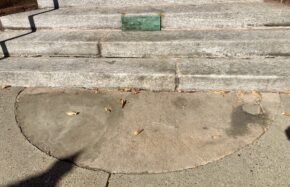Jonathan Edwards’ Non-legacy
 I visited Northampton, Massachusetts, to see what physically remained of the ministry of Jonathan Edwards, who lived in the early 1700s and was the leader of the First Great Awakening and is still considered one America’s greatest theologians. All that remains is the semi-circular stone step of Edwards’ third meeting house, which was placed at the entrance to the present brownstone church building. That’s it.
I visited Northampton, Massachusetts, to see what physically remained of the ministry of Jonathan Edwards, who lived in the early 1700s and was the leader of the First Great Awakening and is still considered one America’s greatest theologians. All that remains is the semi-circular stone step of Edwards’ third meeting house, which was placed at the entrance to the present brownstone church building. That’s it.
 An informational sign placed by the Massachusetts Foundation for the Humanities succinctly tells an essential part of his history: “Edwards’ preaching had been marvelously effective, but he had made serious enemies in the community. There were those who resented Edwards for setting aside the more liberal doctrines of his grandfather, Solomon Stoddard. Others feared that the emotions released by revivals were dangerous. These controversies finally led to his dismissal in 1750, a decision his congregation later came to regret.”
An informational sign placed by the Massachusetts Foundation for the Humanities succinctly tells an essential part of his history: “Edwards’ preaching had been marvelously effective, but he had made serious enemies in the community. There were those who resented Edwards for setting aside the more liberal doctrines of his grandfather, Solomon Stoddard. Others feared that the emotions released by revivals were dangerous. These controversies finally led to his dismissal in 1750, a decision his congregation later came to regret.”
Today his descendent church is full-on woke. Northampton is home to five very liberal colleges and is considered the most LGBT/woke place of Massachusetts. It’s flaunted by stores and people on the sidewalks, and even the crosswalks are painted in the rainbow flag colors.
The tremendous change from then until now is manifest across Western societies and is particularly striking in Northampton. We could say that the church and community lost faith and turned away from God to now become a reflection of the surrounding society.
But beneath the radical change of the society and the church, we might observe that even in Edwards’ day, the church did much the same thing as it is doing today.
Eighteenth-century society was conservative, socially respectable, and church going; that’s how people were and what people did. The majority did not want an uncompromising gospel or especially an unsettling experience of God’s Spirit. That’s precisely why they voted out one of the greatest Christian leaders in American history. Today’s descendant church and others are similarly reflecting the society of today just as Edwards’ church and others reflected the society of their day. From outside observation the two look vastly different, but in truth, people then and now are behaving more or less the same in conforming to their surroundings.
If Jonathan Edwards were to come back to life and visit the place today, I suspect that he might shake his head and move on elsewhere just as he did the first time. God’s Spirit does not stay in the same place like a statue.
The eternal question is this: Will you and I deliberately choose to reflect God’s Word and Spirit—imperfectly as we may do so? Or will we blithely go along with however the culture sways?
The prophet Isaiah’s words still ring true: “If you do not stand firm in your faith, you will not stand at all” (7:9). How will we stand?







